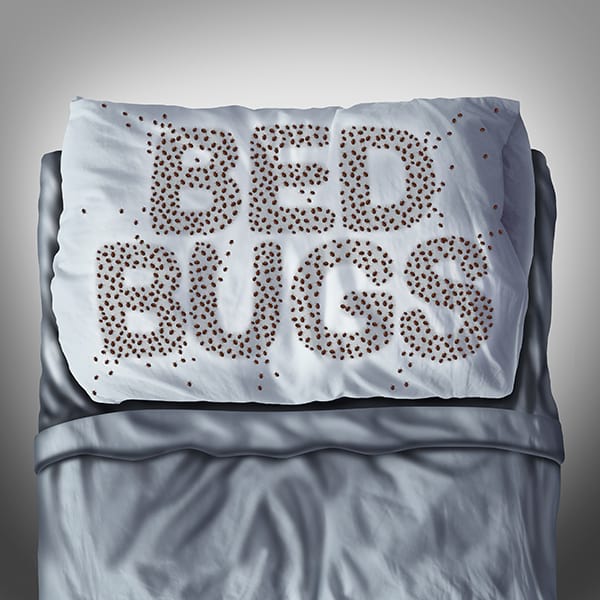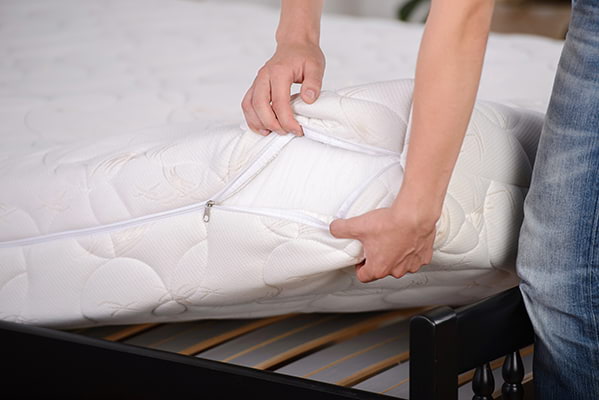
Bed bugs! Just the thought of these little pests can make the hair on the back of anyone’s neck stand straight up. Once they have entered an environment such as a dorm, assisted living facility, or other type of shared living facility, it is a difficult and costly endeavor to get rid of them. Bed bugs are becoming a more consistent problem in student living areas, as they offer the perfect environment for the nuisances to invade and flourish. But, what exactly are these pests and why is prevention important?
A bed bug is a parasite that feeds on the blood of humans much like a tick or a mosquito. They are considered to be a general health concern. While there are no known diseases or direct health problems received from bites, scratching the itchy bumps their bites cause may result in a bacterial infection. Bed bugs prefer to live in crevices of upholstered furniture, like mattresses, and are able to survive in many other areas as well. While there, they continuously feed, lay eggs, and colonize.
One might consider them to be the vampire ant of a sleeping environment, but don’t be fooled! They are capable of infesting far more than bedding, including any upholstered furniture, backpacks, and even shoes or carpeting. While they were eliminated for the most part in the 1940’s, the occurrence of these infestations has been steadily rising since 1995. Today, they have become a common pest problem with infestations surfacing in hotels, dorms, and multi-housing living areas.
Spotting Infestations in Multi-Housing Environments
Bed bugs in dorms are especially common because students come from all over the world. They may be brought in with luggage, on shoes, on clothes, or even already be present in mattresses or headboards from previous residents. Used furniture (like that futon you found on Craiglist) is another typical source, as the pests could already be living there. Bed bugs in dorms are even possible from setting a book bag down on carpet where an infestation is present.
Since they typically feed at nighttime and are very small in size, it’s not always easy to detect them.. While adult bed bugs are about the size of an apple seed and dark in color, younger bugs are much smaller and flesh colored, making them very difficult to spot on lighter surfaced like a mattress. As the number of occurrences continue staggering upward, some higher learning facilities are providing information and tips to students in an effort to prevent infestations. Typical signs of a bed bug problem include:
- Dark red or brown spots on bedding
- Discarded skins from molting
- Sudden bite marks on the body
- Raised, reddish welts on skin
- Burning, itching, or rash in a confined area
- Bump in straight lines (multiple bites in a row)
- A smell similar to rotting raspberries
It is recommended to check the crevices as well as joints of mattresses or furniture for signs of an infestation. Bed bugs are flat, red or brown in color, and have an oval shape. Upholstered furniture should not be the only place checked, as the pests are able to live on shoes, on clothing, in dressers, and other areas of a room or structure.
What Preventative Steps Are Available for Students?
 The best approach is to take active measures for avoiding an infestation of bed bugs in dorms. One recommendation is to put luggage on a rack rather than a bed or the floor when traveling. If this is not available, the next best measure is to vacuum the suitcase upon returning and put all fabric items in the dryer (high heat kills the bugs). When purchasing used furniture, it’s always best to inspect it before bringing it into your residence. A few additional preventative measures students can take include:
The best approach is to take active measures for avoiding an infestation of bed bugs in dorms. One recommendation is to put luggage on a rack rather than a bed or the floor when traveling. If this is not available, the next best measure is to vacuum the suitcase upon returning and put all fabric items in the dryer (high heat kills the bugs). When purchasing used furniture, it’s always best to inspect it before bringing it into your residence. A few additional preventative measures students can take include:
- Full examination of luggage and book bags.
- Wash any clothing prior to bringing it into the dorm.
- Inspect mattresses before placing sheets on them.
- Examine the room itself including chairs, headboards, etc.
- Do not unpack until they have ensured there are no bed bugs.
- Maintain a clean and clutter free room.
- Examine their body for any bites or rashes.
- Use metal or plastic furnishing items without fabric.
Beyond these preventative steps, students may use mattress covers designed to keep bed bugs out. These covers should be used on both the mattress and the box springs to prevent infestation. If there are signs of a problem, the university should be notified immediately to take further pest control actions.
5 Important Preventative Steps for Universities
First, universities should provide information to educate students about these pests and what they can do to keep them out of multi-housing areas. A recent study tested how these pests react to certain colors. As part of the studies findings, scientists determined bed bugs like darker colors that match their own body coloring for shelter. They are not as attracted to brighter colors such as green or yellow. More information about this study can be found in an article recently published by BBC News.
Additionally, headboards covered in fabric are just another place for the pests to hide. Metal or plastic dorm headboards as well as furniture frames are a good way to deter bed bugs in college dorms. Preventative measures may be taken by colleges to reduce the risk of infestation, including limiting the type of furniture brought in by students. Here are a few more tips for avoiding the all too common bed bug problem:
- Choose less pest-friendly furniture for dorm rooms.
- Make protective mattress covers a requirement.
- Use bright, colorful fabrics rather than dark colors.
- Do not allow used furniture into the dorms.
- Performing routine pest inspections and cleaning.
Unnecessary upholstery should be taken out of the equation to remove potential living areas for these pests. Universities should also have measures in place for routine inspections and pest treatments of dorm areas. An increased occurrence of bed bugs in college dorms makes it important to take these preventative measures. Universities must also work with students to educate them about these pests and take steps to mitigate the risk of an infestation.
Ecologic Furniture
At Ecologic Furniture, we want to help every university in this endeavor by providing simple, elegant, metal and plastic solutions for furnishing student housing environments. Less crevices and minimal upholstery make a significant difference in the number of places these little pests can hide. Contact us today to learn how our well-crafted, sustainable furniture solutions are capable of promoting good student health throughout your university.
 ECOLOGIC’S product solutions are designed and constructed for the demanding needs of the residence life market.
ECOLOGIC’S product solutions are designed and constructed for the demanding needs of the residence life market.
 Our furniture is engineered and manufactured to the highest standards and will give years of maintenance-free service.
Our furniture is engineered and manufactured to the highest standards and will give years of maintenance-free service.
 For over 25 years, now we have been a pioneer in sustainable business practices, recycling and green manufacturing.
For over 25 years, now we have been a pioneer in sustainable business practices, recycling and green manufacturing.
 Our customer service agents are happy to provide more information, answer any questions, or even create a quote for you! Call us now! (847) 234-5855 or use our form.
Our customer service agents are happy to provide more information, answer any questions, or even create a quote for you! Call us now! (847) 234-5855 or use our form.


